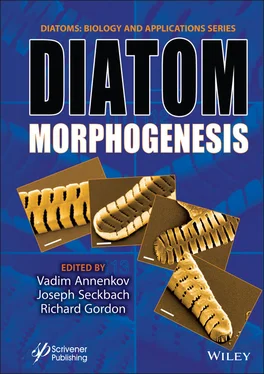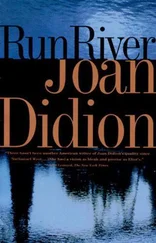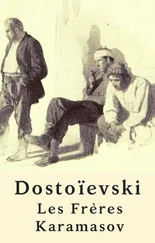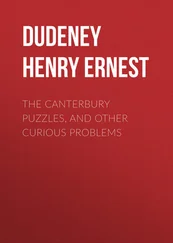Diatom Morphogenesis
Здесь есть возможность читать онлайн «Diatom Morphogenesis» — ознакомительный отрывок электронной книги совершенно бесплатно, а после прочтения отрывка купить полную версию. В некоторых случаях можно слушать аудио, скачать через торрент в формате fb2 и присутствует краткое содержание. Жанр: unrecognised, на английском языке. Описание произведения, (предисловие) а так же отзывы посетителей доступны на портале библиотеки ЛибКат.
- Название:Diatom Morphogenesis
- Автор:
- Жанр:
- Год:неизвестен
- ISBN:нет данных
- Рейтинг книги:5 / 5. Голосов: 1
-
Избранное:Добавить в избранное
- Отзывы:
-
Ваша оценка:
- 100
- 1
- 2
- 3
- 4
- 5
Diatom Morphogenesis: краткое содержание, описание и аннотация
Предлагаем к чтению аннотацию, описание, краткое содержание или предисловие (зависит от того, что написал сам автор книги «Diatom Morphogenesis»). Если вы не нашли необходимую информацию о книге — напишите в комментариях, мы постараемся отыскать её.
A unique book presenting the range of silica structures formed by diatoms, theories and hypotheses of how they are made, and applications to nanotechnology by use or imitation of diatom morphogenesis.
Audience
Diatom Morphogenesis — читать онлайн ознакомительный отрывок
Ниже представлен текст книги, разбитый по страницам. Система сохранения места последней прочитанной страницы, позволяет с удобством читать онлайн бесплатно книгу «Diatom Morphogenesis», без необходимости каждый раз заново искать на чём Вы остановились. Поставьте закладку, и сможете в любой момент перейти на страницу, на которой закончили чтение.
Интервал:
Закладка:
Diatom symmetry formation is closely tied to pattern formation. Models of pattern formation have been developed that consider diffusion limited precipitation in non-equilibrium conditions where silica diffuses within the thin SDV depositing silica initially on the midring in centric diatoms or the midrib in pennate diatoms [2.47, 2.109]. This process has been observed to take about 10 minutes and is followed by thickening of the valve surface, which occupies an additional 6 hours [2.47]. Alternatively, pattern formation has been modeled as phase separation of two hypothesized liquids [2.82, 2.138] so that the repetitive honeycomb and pore patterns formed in some diatoms occur because of the pH regime and molecular reaction during silica deposition [2.76]. The third phase, the actual solid precipitated silica, is not included in this model [2.82]. In an alternate computer simulation, albeit confined to pore occlusions, a single fluid is involved (cf. concentrating “mother liquor” [2.47]), with solid silica particles free to “redissolve” after precipitation [2.161, 2.162]. This is similar to a simulation of diatom costae that permitted surface diffusion of silica particles along the precipitate surface, after they adhered to it, to approximate sintering [2.47]. The balance between precipitation and sintering has been simulated, using the language of “diffusion limited” versus “reaction limited” [2.25]. The main difference is whether silica particles continued to move in the medium [2.25] or along the surface of the precipitate [2.47]. Pore occlusion simulations [2.25] parallel simulation of precipitation with a centric diatom’s midring [2.47]. Spine formation has been modelled as “a combination of membrane and cyto-skeletal activities creating a mold for silica deposition” [2.11], where the silica presumably sinters. A model has been proposed that regards the SDV, in conjunction with the microfilament ring at its perimeter [2.50], as a tensegrity structure that may explain the shape of polygonal centric diatoms [2.48]. All of these models presume that the SDV membrane constrains the silica precipitation, the latter at best somehow enlarging the SDV, by unstated mechanisms. However, the opposite effect, of the precipitated silica altering the shape of the SDV, not just its size, can also be conceived.
Pattern formation diatom studies on cellular organelles during mitotic stages of ontogeny preceding valve formation indicate changes in organelle location and symmetry (cell organization) at the subcellular level as well [2.114, 2.123, 2.155]. For example, during interphase the arrangement of vacuoles on either side of the central area with respect to microtubules and the microtubule organizing center [2.113, 2.122] and spindle formation via the position of the microtubules are indicative of reflective symmetry. As cytokinesis proceeds, at metaphase chromosomes assemble around the spindle during metaphase, while at the end of anaphase complete cleavage of the spindle occurs. The position and cleavage of the spindle exhibit reflective symmetry just prior to the formation of new daughter cells [2.28] (cf. [2.1]).
Each of the modeling systems proposed for diatom valve formation and morphogenesis are incomplete in that they either have not been found to be present during all parts of the process or indirectly attempt to account for morphogenetic processes from a chemical/molecular or cytogenetic viewpoint. As has been emphasized, each “new model of diatom morphogenesis”, which, although highly attractive, is a model, awaiting to be substantiated by TEM-micrographs of sufficiently prepared cells, and experiments undertaken with the living cell” [2.124]. This remains the case. Experiments such as manipulation of salinity have morphogenetic effects, which can be interpreted at the level of silica precipitation [2.157], and the presence of (probably) sodium chloride crystals inside the silicalemma [2.46] is consistent with easy access of small ions into the SDV. The same goes for pH [2.58]. Gene regulation of silica transporters may occur at multiple levels [2.120], perhaps corresponding to multiscalar effects on morphogenesis.
In any case, no model so far accurately simulates the mature silica structure at all scales. This is not surprising, since multiscalar diatom silica structures span an extraordinary 8 orders of magnitude [2.37], and it would seem unlikely that the same mechanism prevails at all size scales (although nested hexagons made of silica spheres of decreasing sizes have been postulated, but not computer simulated, to account for three levels of structure in Coscinodiscus [2.138, 2.139]. The formation of these nanospheres has also been simulated [2.81]. A seven-state cellular automaton model for pennate diatom morphogenesis sets the striae and pores at specific spacings, by unspecified mechanisms [2.12]. At a lower scale, organic microrings of diameter 6 nm may correspond to fultoportulae [2.75]. By looking at each of the models as potential partial mechanisms for producing different aspects of symmetry during different morphogenetic stages and scales, the models may be implicitly useful in addressing how symmetry becomes evident during morphogenesis and how symmetry may be instrumental in understanding stability changes during morphogenesis. However, we presently have no global models that work at all scales. “Better models are needed, therefore, but for this we need a better formulation of the problems we are trying to solve” [2.93].
None of these models for diatom pattern formation involve the linked chemical reactions of Turing reaction-diffusion processes [2.148] which may lead to instabilities that have been invoked for multicellular morphogenesis [2.91, 2.92, 2.99]. However, Turing models have recently been simulated for multilayer situations [2.153], producing patterns somewhat similar to arrays of diatom pores so that such models are still under consideration [2.43].
In a dynamical system, changes in structural stability may be related to changes in symmetry via pattern formation changes not only over time but also at hierarchical spatial scales [2.166]. Pattern formation as an indicator of symmetry states may be evident as self-similarity as well [2.96]. The role of symmetry in developmental processes is discernable through surface pattern and shape changes over time, and these changes may be used in a morphogenetic dynamical system to explicitly assess the contribution of symmetry to structural stability.
In our work on morphogenesis with the late Antone G. Jacobson, we conceived of and repeatedly traversed an intellectual triangular loop of 1) experiments and observations, 2) computer simulation, and 3) formal mathematics, to converge to an understanding of how nature did it [2.49, 2.61–2.64]. This loop has not been traversed or ever closed even once for diatoms. Curiously, in the research with Jacobson, we invoked the bilateral symmetry of the organism we were simulating, which both reduced computer time and made the simulation match reality much better. A similar two axis symmetry was placed on a pennate diatom simulation [2.12]. However, in a real organism there is no global “force” creating its symmetry. Symmetry is a consequence of morphogenesis, not a cause, and deviations from symmetry or its perfection are hints to the underlying processes.
2.1.4 Diatoms and Uncanny Symmetry
Microorganisms are generally not well studied in terms of quantified symmetry changes over time. Diatoms have distinct amorphous silica frustules that exhibit a variety of geometric shapes and surfaces that lend themselves to analyses of symmetries. Diatoms are pigmented protists that are considered to be a monophyletic phylum. Morphogenesis is a topic of great interest not only to phycologists but also to nanotechnologists [2.42, 2.44, 2.51, 2.85]. In girdle view, diatoms are asymmetrical because of the parent-daughter cell division that occurs within the previously formed cell. In valve view, shape and surface are both open to symmetry considerations.
Читать дальшеИнтервал:
Закладка:
Похожие книги на «Diatom Morphogenesis»
Представляем Вашему вниманию похожие книги на «Diatom Morphogenesis» списком для выбора. Мы отобрали схожую по названию и смыслу литературу в надежде предоставить читателям больше вариантов отыскать новые, интересные, ещё непрочитанные произведения.
Обсуждение, отзывы о книге «Diatom Morphogenesis» и просто собственные мнения читателей. Оставьте ваши комментарии, напишите, что Вы думаете о произведении, его смысле или главных героях. Укажите что конкретно понравилось, а что нет, и почему Вы так считаете.












